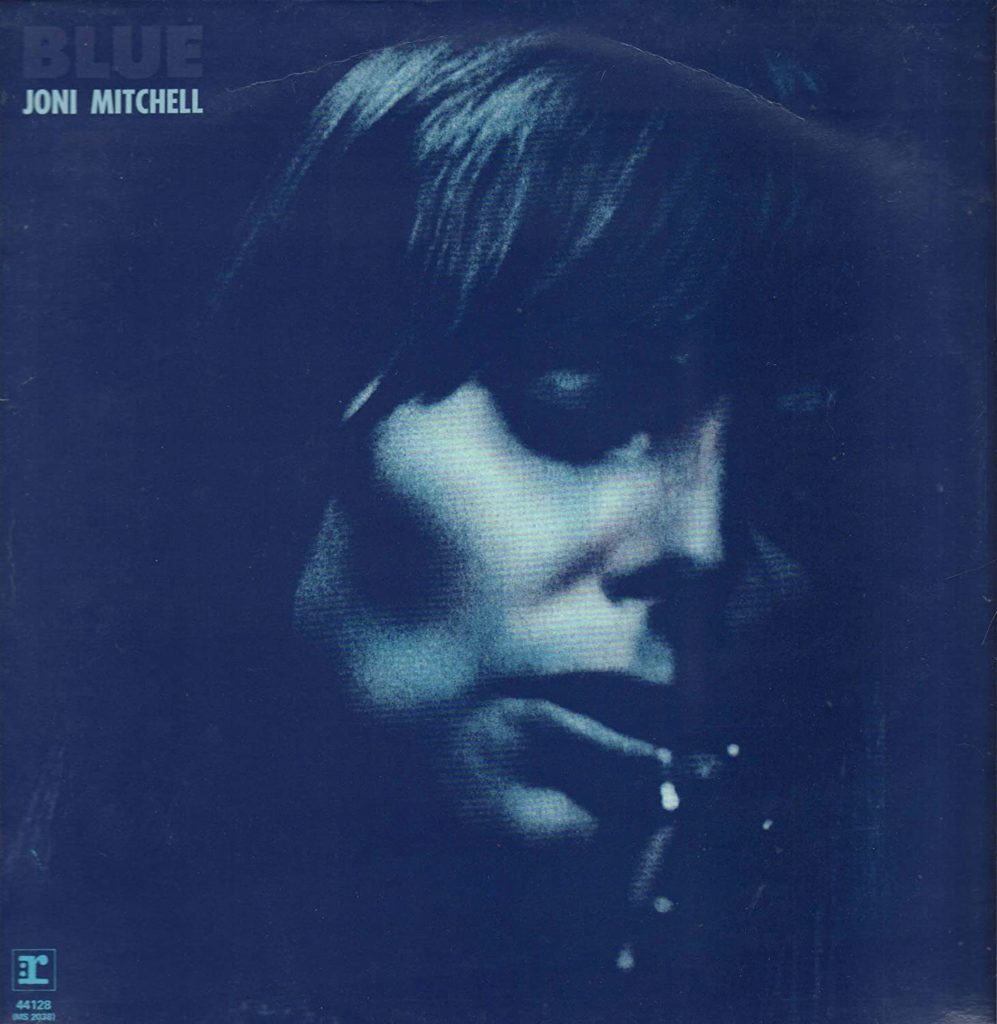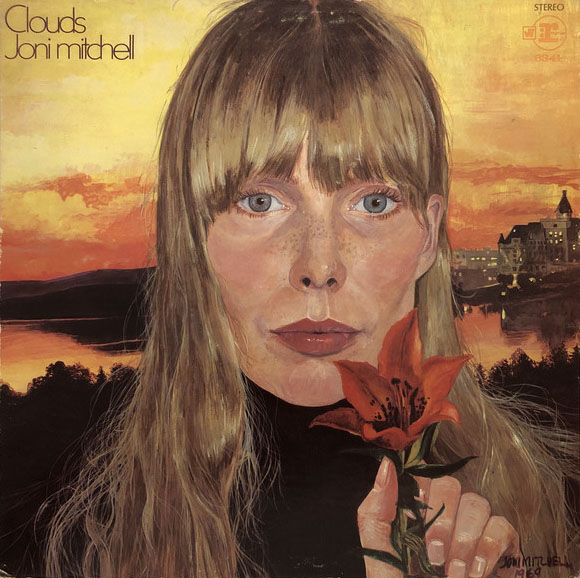It’s been 50 years since Joni Mitchell released her album Blue. The album probably most revered by her long-standing fans, and quite a few critics. It’s also the album that many say not only defined Mitchell as an artist, but also defined the singer-songwriter genre as a whole. It served, and it still serves, as an inspiration to many artists, more or less renowned, some saying that it even served as part of the inspiration for one of Bob Dylan’s best songs, “Tangled Up In Blue.” No matter that Mitchell, for quite a bit of time, didn’t express a very high opinion about Dylan himself.

In many ways, Blue defines Joni Mitchell as a person and the life she’s lived thus far. When many envision Joni Mitchell they think of the soul-baring songs about her love life, along with her features as a young woman with long blond hair on the cover of her albums or photos from her live shows.
But that ‘blue,’ as in sadness and the hurdles that life puts in front of us, has many shades and far more serious instances in Joni’s life that go beyond just her love life with which she’s so openly spoke about in quite a number of her songs. In many ways, it is reflected in the music she came up with throughout her career, which at many points reached brilliant heights, never dropping below the level of ‘quite good,’ before her creative muse started to slowly wane.
It All Started with Singing to Fellow Patients in a Hospital
Roberta Joan Anderson, later to be known as Joni Mitchell did not have the usual ‘dream start’ in music. Unlike many other artists who claim that their love of music came at an early age as they accidentally picked up an instrument, Mitchell had her first encounter with music in some harsh circumstances. She contracted polio at the age of 9, and while in hospital, she started healing herself when she started playing and singing to other patients.
In one of her rare interviews, this one with filmmaker/journalist Cameron Crowe, Mitchell opened up about how the disease led to her becoming a performer. “I was nine, and they put me in a polio ward over Christmas,” Mitchell recalls. “They said I might not walk again and that I would not be able to go home for Christmas.” However, no one was going to dampen young Joni Mitchell’s holiday cheer. “I wouldn’t go for it,” Mitchell says. “So I started to sing Christmas carols, and I used to sing them real loud. When the nurse came into the room I would sing louder. […] And I discovered I was a ham.”
They said I might not walk again and that I would not be able to go home for Christmas. I wouldn’t go for it, So I started to sing Christmas carols
There was yet another consequence that really influenced Mitchell as a musician. Unable to form conventional guitar chords because of weakness in her left hand, she experimented with alternate tunings that have since become part of her signature sound. These days, her tunings and guitar sound are said by the likes of Rolling Sone magazine as “one of the 100 best guitarists of all time, has used up to 50 nonstandard tunings, allowing her to explore rhythm, harmony, and melody in unique and innovative ways.”
Maybe Free-Thinkers Don’t Really Need School
In the same interview with Crowe (1979), Mitchell spoke of her quitting both high school and later on art school. “The way I saw the educational system from an early age was that it taught you what to think, not how to think.”
A part of her schooling problem lay in the fact that in her teenage years she ran with a bit of a rough crowd. Still, she managed to pull out of it, probably through her penchant for writing poetry. Art and art school were her goal so she started earning money as a waitress to be able to enter Alberta College of Art in Calgary. She got there and excelled in her classes. Mitchell’s ability at visual arts is quite evident through paintings and drawings on many of her album covers. But, a year into her studies, she found the prevailing attitudes in art education just as stifling as high school. Not happy with the school’s pigeonholing of students as either commercial or fine artists, she dropped out.
The way I saw the educational system from an early age was that it taught you what to think, not how to think
Working as a department store model, developing her music instrument skills, Joni started playing around local coffee-houses. This was also the time that she was in a relationship with a fellow artist Brad MacMath.
The result of that affair was not so pleasant, to say the least. Mitchell got pregnant, and McMath decided to flee to California, leaving Mitchell penniless, and afraid to contact her parents. Upon giving birth to her daughter, unable to provide for her, she gave her up for adoption. According to The New Yorker, “it was a decision that would haunt her and influence her music for the rest of her life.”
Abundant Love
At one of Toronto’s coffeehouses, Joni met folk musician Chuck Mitchell. Thirty-six hours after they met, Joni and Chuck were married. From Toronto, the then couple moved to Detroit, where they performed as a folk duo. Later on, in an interview Mitchell said, “[o]ne month into the marriage, he chickened out, I chickened out. The marriage had no basis, except to provide a home for the baby.” Mitchell was never able to get her daughter back, and throughout her life, she wasn’t able to make a more meaningful relationship with her.
Mitchell moved to Los Angeles in the second part of the ’60s, and she almost immediately enamored the musicians in the now legendary Laurel Canyon scene, both with her music and her appearance. First to ‘fall’ was David Crosby, who produced Song to a Seagull, her first album in 1968. Although that relationship ended, as did many other of her relationships, Crosby and Mitchell remained in good relations throughout.

While her first album, introduced the audience to her inimitable vocals and innovative guitar style(s), it was Clouds, her second album, that started drawing attention to her songwriting with songs like “Chelsea Morning,” “The Fiddle and the Drum,” and “Both Sides, Now.” It was also the album that delivered her first Grammy ― she went on to win 8 in total.
Ladies of The Canyon (1970) established Mitchell at the forefront of the singer/songwriter movement at the time, with “Woodstock” (which she never attended) becoming the musical anthem of the times.
But it was Blue (1971) that in many ways defines that period of Joni Mitchell’s life and musical career. At the same time, it remains one of the all-time definitive singer/songwriter albums (where a number of other Mitchell albums can fit in easily). It’s also an album that speaks openly about Mitchell’s abundant love life. Quite a number of male artists’ names are on that list including, among others, Graham Nash, James Taylor, Leonard Cohen, Jackson Browne, and Warren Beatty.
Blue as in Jazz
Mitchell started evolving in her musical concepts from there on, moving more and more towards jazz in all its shapes and forms. For The Roses (1972) was like a bridge crossing between ‘pure singer/songwriter’ and new forms and remains as one of her unjustly neglected albums.
Court and Spark (1974) started her inventive, inspired, and imaginative jazz-oriented phase that lasted until 1980 and the Shadows and Light album. In between, Mitchell came up with some intricate masterpieces in Miles of Aisles (1974), Hissing of Summer Lawns (1975), Hejira (1976), Don Juan’s Reckless Daughter (1977), and Mingus (1979).
From there on, every Joni Mitchell album had at least a batch of songs that many other artists would fish out serious money to call their own, but the waning of musical creativity started to slowly creep in.
Part of that waning may lie in the fact that like many L.A. artists of that time, Mitchell became a heavy cocaine user. But then, part of the decline may lie in yet another personal tragedy. In 1982, Mitchell married bassist Larry Klein, who worked on her two more pop-oriented albums of the ’80s. But in 1985, pregnant at the age of 42, Mitchell had a miscarriage. As Klein was constantly doing sessions, Mitchell went through that situation practically alone, probably one of the reasons the couple divorced in the mid-’90s.
Health Problems Multiply
For years, Joni Mitchell has claimed to suffer from a little-understood malady known as Morgellons Disease. Described by the Mayo Clinic as a controversial, unexplained skin condition “characterized by small fibers or other particles emerging from skin sores.” Medical experts disagree about the nature of the ailment and continue to debate whether the disease even exists.
Whether it does or does not exist didn’t matter, and health problems often multiply one onto another. In March 2015, Joni Mitchell was found unconscious in her Los Angeles home. The singer was committed to intensive care, where she underwent tests which revealed she had suffered a crippling brain aneurysm.
Although her official representatives denied initial reports that Mitchell cannot speak, one consequence of her aneurysm became evident ― she wasn’t able to walk properly and would require extensive therapy. Mitchell started reappearing in public a few years later with the effects of her multiple ailments quite visible.
Although this was probably the reason she didn’t make any new recordings in years, there is enough of her musical legacy around to confirm that she is certainly one of the modern music legends.




